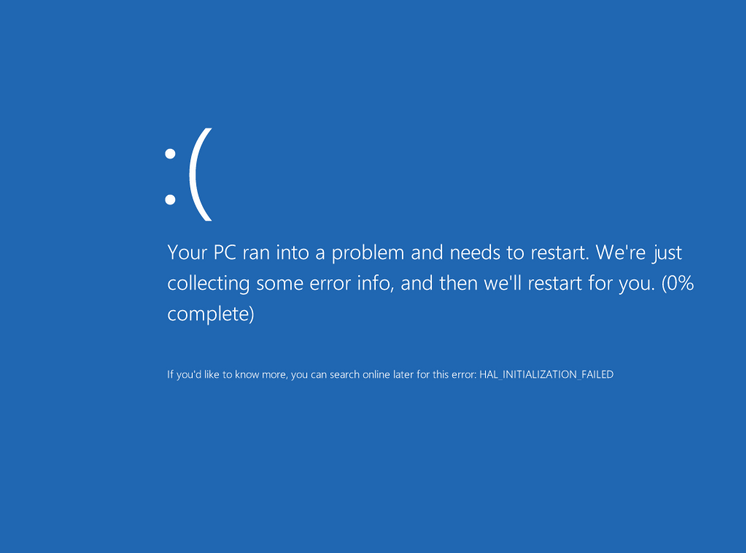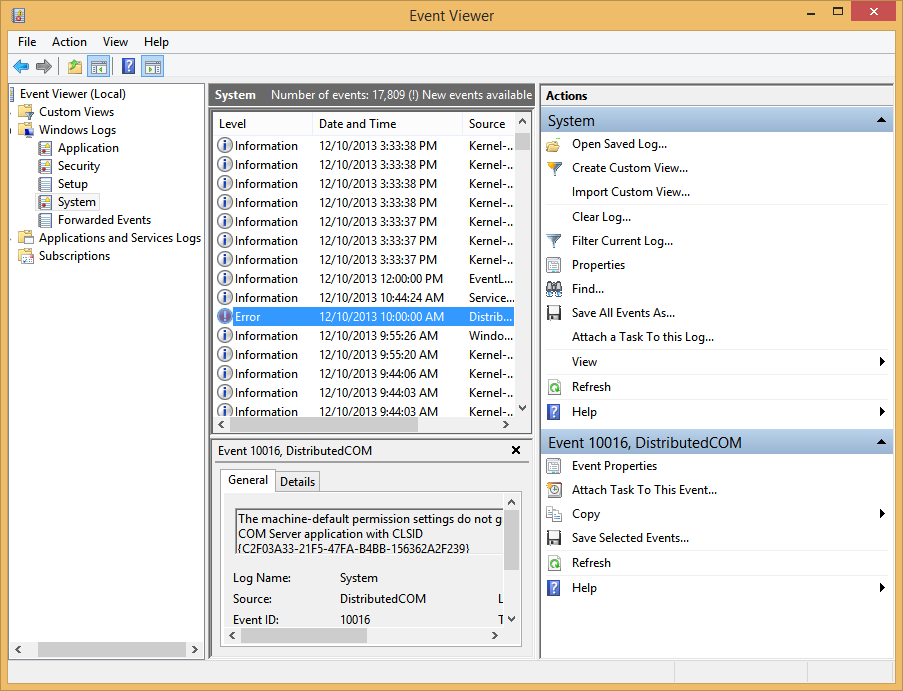-
-
products
-
resources
-
support
-
company
-
How to find out the cause of your BSOD
By Davide De Vellis December 20, 2013Blue Screen of Death, bsod, event viewer2 CommentsThe Blue Screen of Death, or BSOD, has been a constant source of frustration for Windows users over the years. A BSOD occurs when Windows runs into a critical error. When these errors occur, Windows halts whatever it is doing, displays a screen with relevant error information, and restarts the system. Not only are these errors an annoyance, but they can lead to the loss of important data and signify a serious problem with your machine.
How to find out the cause your BSOD
BSODs are serious errors, and unfortunately they have many possible causes as well. Typically, a BSOD of death is indicative of a serious hardware error. However, it may also be the result of a malware infection, faulty driver, or even possibly a software error. Determining the exact cause of your error will take some troubleshooting.

“Blue Screen Of Death (BSOD) in Windows 8”What do all These Error Messages Mean?
The first think you will notice when getting a BSOD is the volume of technical information presented to you. This can often appear intimidating, and to be honest, even more advanced Windows users often don’t understand what they are seeing. These are special error messages known as “STOP codes”. STOP codes provide the user with the necessary information to investigate the error they received. STOP codes may not tell the complete picture, but they provide you with a place to start.
Check out the ReviverSoft Blue Screen Helper, where you can enter the Stop code of your BSOD, it will search our database of errors, and it will provide you with an explanation of the error and recommended solution.Seeing What Windows Knows
In addition to STOP codes, windows also provides valuable troubleshooting information in the Event Viewer. Event Viewer is available on all versions of Windows from XP to Windows 10. However, the process for accessing Event Viewer differs depending on your version.
To access Event Viewer in Windows XP:
- Click the Start Button.
- Click Control Panel.
- Click Performance and Maintenance.
- Click Administrative Tools.
- Click Computer Management.
- Find Event Viewer and Click it.
To access Event Viewer in Windows Vista, and Windows 7:
- Click the Start Button.
- Click Control Panel.
- Click System and Security.
- Click Administrative Tools.
- Click Event Viewer.
To access Event Viewer in Windows 8 and Windows 10:
- Hit the Windows Key.
- Type in “View Events”.
- Hit enter.
Once you’ve accessed Event Viewer, the process for finding out what windows knows about your BSOD is the same across all versions of Windows. To do this:
- Select Windows Logs on the left side of the window.
- You will see a number of sub-categories. Selecting any of these categories will bring up a series of event logs in the center of the screen.
- Any BSOD errors are listed as “Error”.
- Double click any found errors to investigate.
Here you will be presented with any relevant information regarding your errors. Often this will simply display the STOP code reported by the error. However, other errors or warnings could provide clues to your BSOD’s cause. Remember, you can use the ReviverSoft Blue Screen Helper to check for information on these errors and look for any reference to their cause, or search the ReviverSoft Blog. Major search engines like Google and Bing are also a great resource for troubleshooting.

“Event Viewer to look at errors and other items that have occured on your system”Determining if Hardware is at Fault
While its true that a BSOD of death has many possible causes, hardware problems are by far the most common. As such, it’s often a good idea to start your troubleshooting here. Have you made any changes to your hardware recently? If so, try reinstalling any relevant drivers. You can always run Driver Reviver to identify missing or incorrect drivers for you. The good thing is that if any BSOD errors coincide with the addition of hardware, it is highly likely that this hardware is to blame.
If you haven’t made any changes to hardware, you may be experiencing an issue with aging or faulty hardware. Two of the most common hardware causes of a BSOD are faulty memory and overheating. Your system can be tested for faulty memory by following the instructions outlined in our Memory Test article. If your system is overheating, you should take steps to address this problem immediately. An overheated PC can wreck havoc on your system’s hardware, turning a relatively simple problem into an expensive one. There are a few simple ways to determine if your PC is overheating.
Does your PC…
- Run abnormally hot?
- Are the fans abnormally loud?
- Is the ventilation blocked or full of dust?
If any of these are true, you may have a serious overheating problem. Start by cleaning the dust out of the fan and making sure the ventilation is free of obstruction. Many laptops have succumbed to overeating when their vents became obstructed during late night Netflix binges in bed. You can also checkout our article on Overheating for potential solutions.
Scanning for Malware
If you are unable to find a hardware cause for your errors, it is advisable to conduct a malware scan. Using a reputable anti-malware or anti-virus program, scan your PC for any malware or viruses. These types of programs are composed of malicious code to exploit or damage your PC. This can often lead to a BSOD, among many other serious complications. You can check our article on the Best Anti-Malware to choose a free solution to help with your scan if you don’t have one installed already.
Was this post helpful?YesNoFree Driver Updates
Update your drivers in less than 2 minutes to enjoy better PC performance - Free.
Free Driver Updates
Update your drivers in less than 2 minutes to enjoy better
PC performance - Free.
Didn't find your answer?Ask a question to our community of experts from around the world and receive an answer in no time at all.most relevant recent articles Pin It on Pinterest